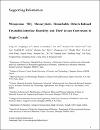Mesoporous TiO2 Mesocrystals: Remarkable Defects-Induced Crystallite-Interface Reactivity and Their in Situ Conversion to Single Crystals
| المؤلف | Liu, Yong |
| المؤلف | Luo, Yongfeng |
| المؤلف | Elzatahry, Ahmed A. |
| المؤلف | Luo, Wei |
| المؤلف | Che, Renchao |
| المؤلف | Fan, Jianwei |
| المؤلف | Lan, Kun |
| المؤلف | Al-Enizi, Abdullah M. |
| المؤلف | Sun, Zhenkun |
| المؤلف | Li, Bin |
| المؤلف | Liu, Zhengwang |
| المؤلف | Shen, Dengke |
| المؤلف | Ling, Yun |
| المؤلف | Wang, Chun |
| المؤلف | Wang, Jingxiu |
| المؤلف | Gao, Wenjun |
| المؤلف | Yao, Chi |
| المؤلف | Yuan, Kaiping |
| المؤلف | Peng, Huisheng |
| المؤلف | Tang, Yun |
| المؤلف | Deng, Yonghui |
| المؤلف | Zheng, Gengfeng |
| المؤلف | Zhou, Gang |
| المؤلف | Zhao, Dongyuan |
| تاريخ الإتاحة | 2016-10-23T07:03:40Z |
| تاريخ النشر | 2015-10-28 |
| اسم المنشور | ACS Central Science |
| المعرّف | http://dx.doi.org/10.1021/acscentsci.5b00256 |
| الاقتباس | Liu Y, Luo Y, Elzatahry AA, et al. Mesoporous TiO2 Mesocrystals: Remarkable Defects-Induced Crystallite-Interface Reactivity and Their in Situ Conversion to Single Crystals. ACS Central Science. 2015;1(7):400-408. |
| الرقم المعياري الدولي للكتاب | 2374-7951 |
| الملخص | Oriented self-assembly between inorganic nanocrystals and surfactants is emerging as a route for obtaining new mesocrystalline semiconductors. However, the actual synthesis of mesoporous semiconductor mesocrystals with abundant surface sites is extremely difficult, and the corresponding new physical and chemical properties arising from such an intrinsic porous mesocrystalline nature, which is of fundamental importance for designing high-efficiency nanostructured devices, have been rarely explored and poorly understood. Herein, we report a simple evaporation-driven oriented assembly method to grow unprecedented olive-shaped mesoporous TiO2 mesocrystals (FDU-19) self-organized by ultrathin flake-like anatase nanocrystals (∼8 nm in thickness). The mesoporous mesocrystals FDU-19 exhibit an ultrahigh surface area (∼189 m2/g), large internal pore volume (0.56 cm3/g), and abundant defects (oxygen vacancies or unsaturated Ti3+ sites), inducing remarkable crystallite-interface reactivity. It is found that the mesocrystals FDU-19 can be easily fused in situ into mesoporous anatase single crystals (SC-FDU-19) by annealing in air. More significantly, by annealing in a vacuum (∼4.0 × 10–5 Pa), the mesocrystals experience an abrupt three-dimensional to two-dimensional structural transformation to form ultrathin anatase single-crystal nanosheets (NS-FDU-19, ∼8 nm in thickness) dominated by nearly 90% exposed reactive (001) facets. The balance between attraction and electrostatic repulsion is proposed to determine the resulting geometry and dimensionality. Dye-sensitized solar cells based on FDU-19 and SC-FDU-19 samples show ultrahigh photoconversion efficiencies of up to 11.6% and 11.3%, respectively, which are largely attributed to their intrinsic single-crystal nature as well as high porosity. This work gives new understanding of physical and chemical properties of mesoporous semiconductor mesocrystals and opens up a new pathway for designing various single-crystal semiconductors with desired mesostructures for applications in catalysis, sensors, drug delivery, optical devices, etc. |
| راعي المشروع | State Key Basic Research Program of China (2013CB934104 and 2012CB224805), the National Science Foundation (21210004) and Science & Technology Commission of Shanghai Municipality (14JC1400700), Shanghai Leading Academic Discipline Project (B108), and Deanship of Scientific Research, KSU-The International Highly Cited Research Group program (IHCRG#14-102). Y.L. also acknowledges the Interdisciplinary Outstanding Doctoral Research Funding of Fudan University (EZH2203302/001). |
| اللغة | en |
| الناشر | American Chemical Society |
| الموضوع | Ordered superstructures Crystallization Evaporation |
| النوع | Article |
| الصفحات | 400-408 |
| رقم العدد | 7 |
| رقم المجلد | 1 |
الملفات في هذه التسجيلة
هذه التسجيلة تظهر في المجموعات التالية
-
علم وتكنولوجيا المواد [341 items ]



